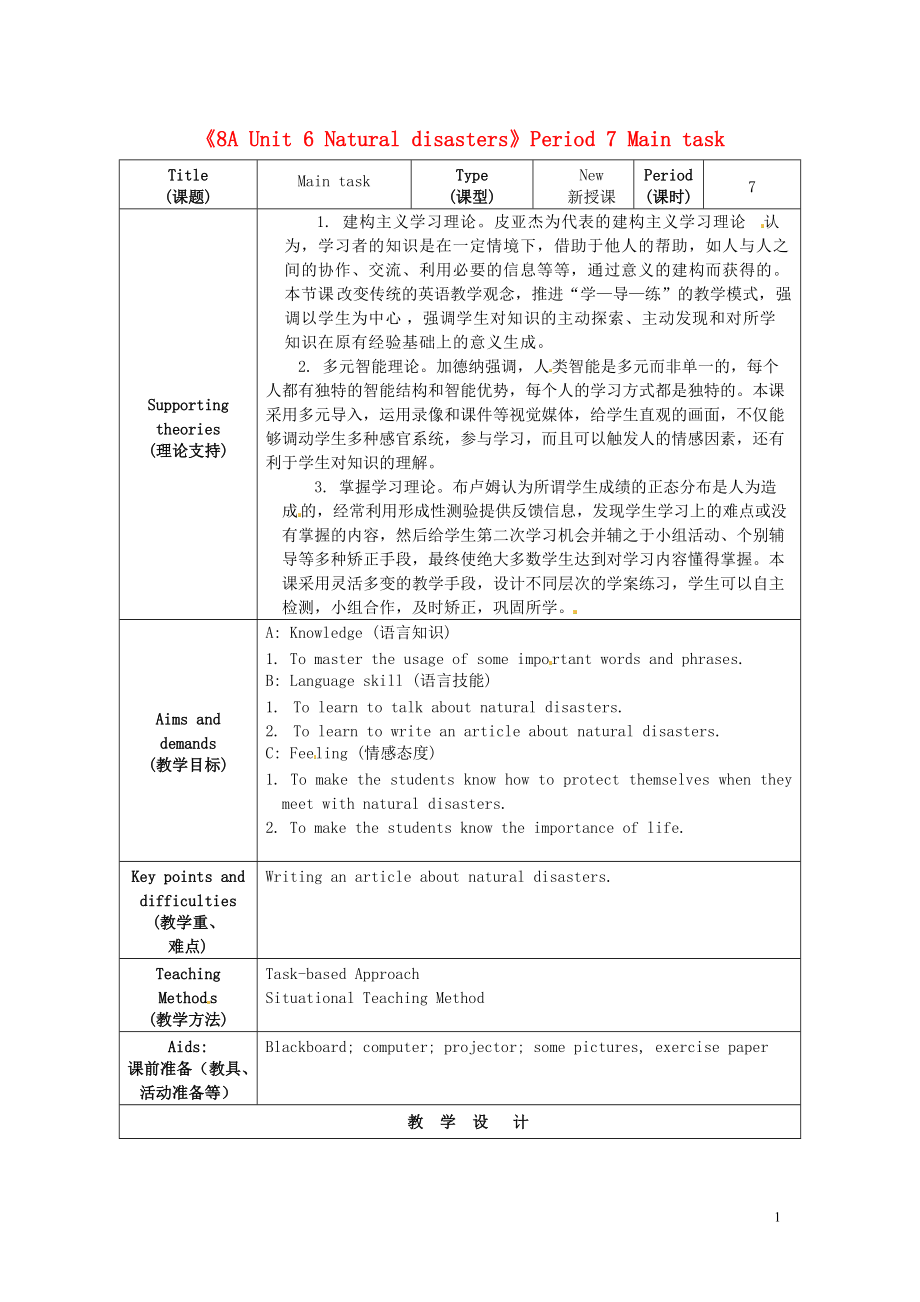《江蘇省海安縣大公初級中學(xué)八年級英語上冊《8A Unit 6 Natural disasters》Period 7 Main task教案 牛津版》由會員分享�����,可在線閱讀���,更多相關(guān)《江蘇省海安縣大公初級中學(xué)八年級英語上冊《8A Unit 6 Natural disasters》Period 7 Main task教案 牛津版(4頁珍藏版)》請在裝配圖網(wǎng)上搜索。
1�、
《8A Unit 6 Natural disasters》Period 7 Main task
Title
(課題)
Main task
Type
(課型)
New
新授課
Period
(課時)
7
Supporting theories
(理論支持)
1. 建構(gòu)主義學(xué)習(xí)理論。皮亞杰為代表的建構(gòu)主義學(xué)習(xí)理論認為���,學(xué)習(xí)者的知識是在一定情境下�,借助于他人的幫助���,如人與人之間的協(xié)作���、交流、利用必要的信息等等���,通過意義的建構(gòu)而獲得的���。本節(jié)課改變傳統(tǒng)的英語教學(xué)觀念�,推進“學(xué)—導(dǎo)—練”的教學(xué)模式�,強調(diào)以學(xué)生為中心,強調(diào)學(xué)生對知識的主動探索�、主動發(fā)現(xiàn)和對所學(xué)知識在原有經(jīng)
2、驗基礎(chǔ)上的意義生成�。
2. 多元智能理論。加德納強調(diào)��,人類智能是多元而非單一的���,每個人都有獨特的智能結(jié)構(gòu)和智能優(yōu)勢��,每個人的學(xué)習(xí)方式都是獨特的�。本課采用多元導(dǎo)入����,運用錄像和課件等視覺媒體,給學(xué)生直觀的畫面�����,不僅能夠調(diào)動學(xué)生多種感官系統(tǒng),參與學(xué)習(xí)��,而且可以觸發(fā)人的情感因素���,還有利于學(xué)生對知識的理解���。
3. 掌握學(xué)習(xí)理論。布盧姆認為所謂學(xué)生成績的正態(tài)分布是人為造成的�����,經(jīng)常利用形成性測驗提供反饋信息���,發(fā)現(xiàn)學(xué)生學(xué)習(xí)上的難點或沒有掌握的內(nèi)容,然后給學(xué)生第二次學(xué)習(xí)機會并輔之于小組活動���、個別輔導(dǎo)等多種矯正手段����,最終使絕大多數(shù)學(xué)生達到對學(xué)習(xí)內(nèi)容懂得掌握��。本課采用靈活多變的教學(xué)手段��,設(shè)計不同層次的學(xué)案練習(xí),
3����、學(xué)生可以自主檢測,小組合作����,及時矯正,鞏固所學(xué)��。
Aims and demands
(教學(xué)目標)
A: Knowledge (語言知識)
1. To master the usage of some important words and phrases.
B: Language skill (語言技能)
1. To learn to talk about natural disasters.
2. To learn to write an article about natural disasters.
C: Feeling (情感態(tài)度)
1. To make the
4���、students know how to protect themselves when they meet with natural disasters.
2. To make the students know the importance of life.
Key points and difficulties
(教學(xué)重�、
難點)
Writing an article about natural disasters.
Teaching Methods
(教學(xué)方法)
Task-based Approach
Situational Teaching Method
5��、
Aids:
課前準備(教具���、活動準備等)
Blackboard; computer; projector; some pictures, exercise paper
教 學(xué) 設(shè) 計
課前延伸
(預(yù)習(xí))
1.聽磁帶�����,預(yù)習(xí)Main task部分的生詞���。
(會拼寫��、知詞義)
2.解決疑難問題���。
(個人思考,小組討論��,待課上求助)
3.查閱與自然災(zāi)害內(nèi)容相關(guān)的資料���,以備課上合作交流���。
養(yǎng)成自學(xué)習(xí)慣,培養(yǎng)自學(xué)能力
Teaching Plan
(授課計劃)
Studying Plan
(學(xué)習(xí)計劃)
Aims
(設(shè)計意圖)
6���、
課
內(nèi)
拓
展
學(xué)
StepⅠWarming up
1.檢查課前預(yù)習(xí),各組代表交流對自然災(zāi)害的了解情況����,再提出組內(nèi)無法解決的疑難問題�����。
Step II Presentation
(Pre-reading)
1. Teach the new words.
2. Say something about the storm according to the pictures.
1.檢查預(yù)習(xí)單詞情況����,為接下來的環(huán)節(jié)做好鋪墊。
7���、
2.學(xué)生討論時采用相互問答或?qū)υ挼男问?���,在語境中運用生詞�,激發(fā)學(xué)生興趣,對Main task內(nèi)容有進一步的認識���。
導(dǎo)
Step III
Practice
( While-
reading)
Ⅰ. Skimming
Skim the article
1. 通過對學(xué)生的聽讀訓(xùn)練����,培養(yǎng)搜索有用信息的能力�����。
練
II.
Production
III.
Writing
Show some pictures about the sno
8��、wstorm. Talk about them with the whole class and encourage students to make some sentences according to these pictures and key words provided beside each picture.
E.g.
A snowstorm hit Beijing on Friday, 28th January.
People shared umbrellas with others.
Sandy and Millie lost their umbrella in t
9����、he wind.
People could only walk slowly in the snow.
People were working hard to remove the snow. Explain ‘remove’ is a verb. It means ‘move away’.
1.Discuss (分析每個段落分別屬于流程圖中的哪個部分)
Para.1 Introduction.
Para.2 During the snowstorm.
Para.3 After the snowstorm.
2. Write an article according to the pictures
1.提高學(xué)生的語言表達能力。
1.強化聽說訓(xùn)練�����,提高學(xué)生對文章細節(jié)的理解和推斷能力。繼續(xù)進行過程性評價�。
課后提升
Step V Assignment
1. Recite all the new words.
2. Find more information about natural disasters on the Internet.
1.控制作業(yè)量,既落實雙基����,又重視知識面的拓寬和能力的提升。(關(guān)心學(xué)生的認知發(fā)展)
4
 江蘇省海安縣大公初級中學(xué)八年級英語上冊《8A Unit 6 Natural disasters》Period 7 Main task教案 牛津版
江蘇省海安縣大公初級中學(xué)八年級英語上冊《8A Unit 6 Natural disasters》Period 7 Main task教案 牛津版

